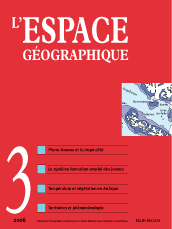

French geographers and tropicality with respect to Monsoon Asia
Colonial geography, which became tropical geography after decolonisation, has taken several decades to put the effect of natural environment on Monsoon Asia’s societies into perspective. It is still implicit for geographers who criticize development and environmental politics imposed on the South by the North. A systemic approach gives spatial systems (geo-historical, demographic, industrial and urban) the same importance as the environment. Tropicality, which for too long expressed a radical otherness in scientific knowledge developed in Western Europe, has been epistemologically stronger and more institutionalised in French-language geography than in English-language geography.
keywords: CIVILISATION, COLONIZATION, EPISTEMOLOGY, SYSTEMS, TROPICALITY
Geography, tropicality and postcolonialism: Anglophone and Francophone readings of the work of Pierre Gourou
Readings of the work of Pierre Gourou shed some interesting light on the different bearing that the critical constructs of ‘tropicality’ and postcolonialism currently have on Anglophone and Francophone geography. The paper shows how Francophone appreciation of Gourou has been couched in disciplinary terms, underlining the absence of a strong postcolonial orientation within French geography, whereas an Anglophone literature on tropicality has tended to caricature the involvement of Pierre Gourou and French tropical geography. The need for, and possible means of, closer Anglo- French dialogue over geography’s complicity in tropicality is commented upon.
keywords: PIERRE GOUROU, POST-COLONIALISM, TROPICAL GEOGRAPHY, TROPICALITY
The spatial dimension of training and employment systems (9 fig., 2 tabl.)
The initial training and entry of young French people into the job market have a spatial dimension. Training and employment spatial systems can be defined as recruitment and placement areas, underpinned by the spatial trajectories of young people and a specific interplay between agents (the State, local government, students, families and employers). This interplay is itself related to space. The educational levels of the secondary matriculation certificate (baccalauréat) and the four-year university degree are used here to distinguish three types of training and employment spatial systems in France. Research by geographers and economists sheds light on the way these systems operate.
keywords: EMPLOYMENT, ENTRY INTO THE JOB MARKET, SYSTEMS, TRAINING
Éric F. LAMBIN. A systemic approach of the causes of the Brazilian Amazon deforestation: syndromes, synergies and feedbacks. (2 fig.)
This paper applies a systemic analysis to deforestation in the Brazilian Amazon, by focusing on feedbacks and synergetic combinations of multiple causes. The causes of deforestation are first described by sector of activity and level of organisation. The major “syndromes” of deforestation are then identified: scarcity of factors of production putting pressure on resources, outside policy intervention altering the decision-making parameters of local actors, market opportunities, and changes in social organisation. By representing the complexity of the deforestation process, this approach has significant implications for policy design and calls for new methodological developments.
keywords: BRAZILIAN AMAZON, CAUSAL SYNERGIES, DEFORESTATION, DEVELOPMENT POLICY, LAND USE
Arve ELVEBAKK, Thierry BROSSARD. Vegetation and temperature distribution in Kongsfjorden, Svalbbard, 79°N: formalised spatial approach. (1 encadré, 7 fig., 1 photo, 1 tabl.)
Climate change is a key issue, especially in the Arctic. However, this general observation is not sufficient to determine the consequences of this phenomenon since the impact of climate change varies with geographical position and local conditions in different environmental contexts. The study area is located at 79°N, in Kongsfjorden (Svalbard). Botanical observations and temperature measurements, remote sensing and topographical indices are input into a Geographical Information System. These GIS layers are then computed to provide variables that can give a statistical explanation of the temperature and vegetation distribution at high resolution.
keywords: ARCTIC, BIOCLIMATOLOGY, INTERPOLATION, SPATIAL MODELLING
Phenomenological pragmatics of the territorial and ideological constructions in the dwellers’views (3 fig.)
This article develops a method of phenomenological analysis of the relationships that dwellers maintain with the world around them. It attempts to rethink those relationships by showing that they position the resident as a being projected into a world that is understood here as both the context of the dweller’s existence and the context of the interpretation of that existence. This perspective based on dwellers’ views prompts a review of the conceptual and methodological procedure for addressing those relationships both in terms of the explanations the dweller gives of the world and in terms of the explanations that the dweller gives to him/herself in order to understand that world and him/herself in accordance with his hermeneutic circle.
keywords: IDEOLOGICAL CONSTRUCT, PHENOMENOLOGICAL APPROACH, SOCIOLINGUISTICS, TERRITORIAL CONSTRUCTION, VIEWS
Book reviews
In this issue of l’Espace géographique, you will find critical reviews of the following books
ALLEN J. (2003). Lost geographies of power. Oxford: Blackwell, 217 p. (Matthieu Giroud, université de Poitiers)
BARTHE-DELOIZY F. (2003). Géographie de la nudité. Être nu quelque part. Rosny-sous-Bois: Bréal, coll. «d’Autre part», 239 p. (Jean-Christophe Gay, université Paul Valéry de Montpellier)
RADVANYI J. (dir.) (2003). Les États postsoviétiques. Paris: Armand Colin, 235 p. (Denis Eckert,, CNRS Toulouse)
TAILLARD Ch. (dir.) (2004). Intégrations régionales en Asie orientale. Paris: Les Indes savantes, 495 p. (Franck Auriac, université d’Avignon)
L’espace géographique 2/06![]()
![]() L’espace géographique 4/06
L’espace géographique 4/06
For subscribe or buy this issue: BELIN
![]() L’Espace géographique: contents
L’Espace géographique: contents
Last modified: September 25, 2006